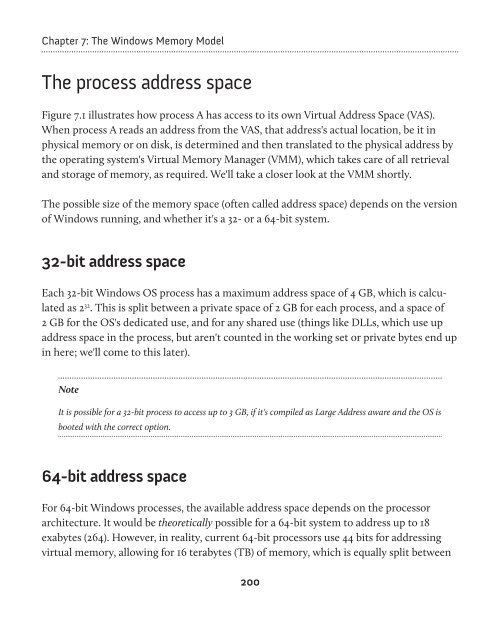Under the Hood of .NET Memory Management - Simple Talk
Under the Hood of .NET Memory Management - Simple Talk
Under the Hood of .NET Memory Management - Simple Talk
You also want an ePaper? Increase the reach of your titles
YUMPU automatically turns print PDFs into web optimized ePapers that Google loves.
Chapter 7: The Windows <strong>Memory</strong> Model<br />
The process address space<br />
Figure 7.1 illustrates how process A has access to its own Virtual Address Space (VAS).<br />
When process A reads an address from <strong>the</strong> VAS, that address's actual location, be it in<br />
physical memory or on disk, is determined and <strong>the</strong>n translated to <strong>the</strong> physical address by<br />
<strong>the</strong> operating system's Virtual <strong>Memory</strong> Manager (VMM), which takes care <strong>of</strong> all retrieval<br />
and storage <strong>of</strong> memory, as required. We'll take a closer look at <strong>the</strong> VMM shortly.<br />
The possible size <strong>of</strong> <strong>the</strong> memory space (<strong>of</strong>ten called address space) depends on <strong>the</strong> version<br />
<strong>of</strong> Windows running, and whe<strong>the</strong>r it's a 32- or a 64-bit system.<br />
32-bit address space<br />
Each 32-bit Windows OS process has a maximum address space <strong>of</strong> 4 GB, which is calculated<br />
as 2 32 . This is split between a private space <strong>of</strong> 2 GB for each process, and a space <strong>of</strong><br />
2 GB for <strong>the</strong> OS's dedicated use, and for any shared use (things like DLLs, which use up<br />
address space in <strong>the</strong> process, but aren't counted in <strong>the</strong> working set or private bytes end up<br />
in here; we'll come to this later).<br />
Note<br />
It is possible for a 32-bit process to access up to 3 GB, if it's compiled as Large Address aware and <strong>the</strong> OS is<br />
booted with <strong>the</strong> correct option.<br />
64-bit address space<br />
For 64-bit Windows processes, <strong>the</strong> available address space depends on <strong>the</strong> processor<br />
architecture. It would be <strong>the</strong>oretically possible for a 64-bit system to address up to 18<br />
exabytes (264). However, in reality, current 64-bit processors use 44 bits for addressing<br />
virtual memory, allowing for 16 terabytes (TB) <strong>of</strong> memory, which is equally split between<br />
200











